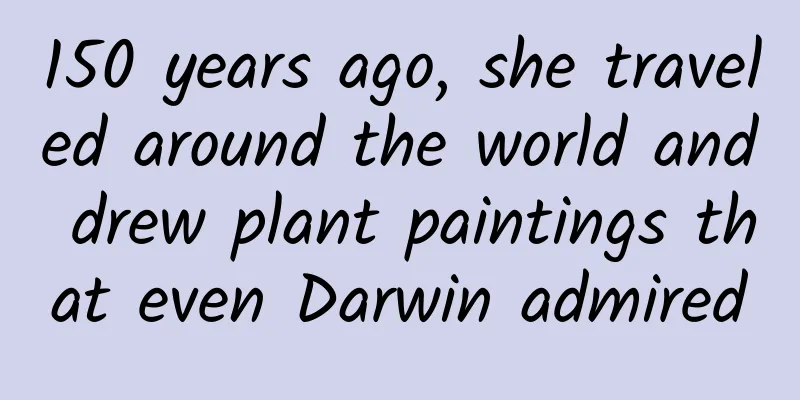150 years ago, she traveled around the world and drew plant paintings that even Darwin admired

|
More than one hundred and fifty years ago, a woman set out from England and began her solo journey around the world. In the past 14 years, she has traveled across six continents, through wild jungles, looking for different plants and recording them with her brush . She has painted the 100-meter-high redwoods in California, and her favorite plant, the pitcher plant in Borneo. Even the scientific name of the pitcher plant is named after her. Later, she took the initiative to contact Kew Gardens and built her own gallery in the world's most famous botanical garden. More than 800 of her botanical paintings are displayed here, which is still the only permanent solo exhibition created by a woman in the UK . Her name is Marianne North . North in Sri Lanka in 1877 (left); North in South Africa in 1883 (right)|RBG Kew In a time when women were not allowed to travel alone Born into a wealthy family in 1830, North visited Kew Gardens with her father when she was 26. William Hooker, then director of Kew Gardens and a friend of her father, gave her a bouquet of flowering Amherstia nobilis. This is a tropical plant native to Burma and Thailand, known as the "Light of Burma". North was immediately fascinated by this red tropical flower, and a desire surged in her heart - she wanted to visit the tropics . Years later, she recalled that this desire was like the prelude to the beginning of a revolution. North painted Amherstia nobilis in Singapore in 1876 | RBG Kew Over the next thirty years, North began her rebellion. She had a talent for painting since she was a child, which was supported by her family because painting was seen as a hobby suitable for women at the time. But she wanted more than just painting - she wanted to travel to faraway places and paint various plants, which was impossible at the time. In the Victorian era, women had no opportunity to receive formal education in the arts or sciences . Society required them to marry, focus on the family, and not travel alone without a husband or other male companion. North felt that marriage would turn women into "superior servants." She had no interest in marriage and often traveled with her father, with whom she had a good relationship. In 1869, her father died, and she was devastated. At the age of 40, she was determined to realize the aspirations of her youth. In 1871, she boarded a ship to America. In the following fourteen years, she traveled alone - from the United States, Jamaica to Brazil, from Japan, Borneo to India, she went to fifteen countries, allowing countless plants to live forever in her paintings. Traveling around the world alone since I was 40 It was so exciting to realize a dream that North wrote in his diary: "I was in such a state of ecstasy that I hardly knew what to paint first." But in fact, her journey was not easy. She often had to endure storms and high temperatures, typhoid and fractures, and long periods of lack of access to clean water . She lived in a hut in the Brazilian rainforest for nearly a year and was always infested by ticks. But she felt that she could bear it because "that quiet corner of the forest is full of miracles and the joy of life." During this year in Brazil, she kept painting and created more than 100 works. Traveling through the Brazilian rainforest|RBG Kew Loneliness is inevitable. North often walks in the wilderness for hours without any companions. Such wandering allows her to observe nature carefully . In her eyes, this is the best life. North has had her fair share of adventures. She once described a Brazilian engineer who appeared “like from the moon or something” to help her steer the boat to her next destination. Her sincerity seems to attract goodwill wherever she goes. Old Banyan Tree in Java|RBG Kew Traveling alone is not without fear. In Petrópolis, Brazil, she wanted to see Organ Mountain. The locals persuaded her not to go up the mountain, telling her stories of escaped slaves. She felt more and more uncomfortable and homesick, but she couldn't resist her curiosity about Organ Mountain. So she insisted on looking for a guide and finally found a mason who knew the way. Fortunately, they did not encounter any accidents and soon reached the top of the mountain. She couldn't help but laugh at herself for looking for "difficulties and dangers" in vain along the way. Fortunately, she was not scared off and finally got a good view of the top of the mountain . North's sister commented on her sister, saying that although she was not a botanist in the professional sense, she treated the beautiful and vivid life of plants just as we humans treat our friends . When she was in California, she was in awe of the giant redwoods and called for their protection and reduction in destruction. A century before the modern environmental movement began, she issued a sad cry against quarrying and chemical abuse: "It breaks my heart to think that human beings, so-called civilized human beings, have wasted in a few years treasures that savages and animals have never destroyed in centuries." Fallen Redwood|RBG Kew Breaking the Rules of Botanical Painting In the Victorian era, botanical paintings were often created using watercolors on light backgrounds, but North deviated from the traditional method and instead used oil paints , which gave her work a vibrant and impactful look. In fact, when North first taught herself to paint, she also used watercolors. It was not until 1868, when she was 38 years old, that she took her first oil painting class. But this class made her imagination burst forth. She described painting with oils as very addictive: "It's like a bad habit, once you have it, you can hardly get rid of it." Painting plants with oils brought new benefits to plant painting - oils can perfectly preserve colors , while watercolors will fade and yellow over time. Lotus of Java|RBG Kew Water lilies in South Africa|RBG Kew To study North's painting habits, Kew worked with the Hamilton Kerr Institute in Cambridge to extract pinhead-sized samples from 43 paintings and examine them under a microscope. The researchers found that all the works showed a similar structure: a white background and one or two layers of paint. Her preference for specific colors , such as cobalt blue, lead white and madder red, and her lack of use of black pigments , may explain why her paintings appear so bright and bold. For North, who traveled a lot, using limited colors also allowed her to not have to carry too many paints and palettes with her. Othonna parviflora in South Africa|RBG Kew Unlike traditional botanical illustrations, North also included the natural environment in which the plants were located , including animals, temples, and people. This allowed people to understand the habitats of these plants - these were distant places that many Europeans had never been to and unfamiliar plants that they had never seen. In an era when photography was not yet popular, her works were vivid snapshots of plants. Mount Fuji surrounded by wisteria|RBG Kew North named this painting The Aqueduct of Morro Velho, Brazil, as if the main subject is the aqueduct in the distance; but the picture vividly presents the relationship between Convolvulaceae, Musaceae and hummingbirds|RBG Kew A Crinum orchid painted in Jamaica, North painted the night sky to intuitively convey the characteristics of this plant blooming at night|RBG Kew The accuracy and expressiveness of her paintings sparked a revolution in both the botanical and fine art worlds. Darwin (yes, they were contemporary) was mesmerized by North’s paintings and soon became her friend. In 1880, on Darwin’s advice, she traveled to Borneo, Australia, and New Zealand, where she created 300 paintings. North painted Darwin's orchid in South Africa. Darwin predicted that the orchid's long spurs would mean that the insects that pollinate it would have beaks of equal length. North quoted Darwin's prediction in the description of this painting, even though it had not yet been confirmed. | RBG Kew Crossing the line between art and science While traveling in Borneo, North drew the pitcher plant, one of her greatest fascinations. The plant had no scientific name at the time, and the drawing caused a stir among botanists. The plant was eventually named after her, Nepenthes northiana . Her paintings brought more discoveries to the plant world at that time. Many plant names have traces of her, such as Kniphofia northiae and Crinum northianum . She painted many local species in the Seychelles Islands. One of the trees was identified as a species of the Sapotaceae family, but it could not be classified into any genus at that time. Therefore, this new genus was named Northia after her. The Northia seychellana she painted in the Seychelles is the only confirmed species in the genus Portuguese olive. | RBG Kew More than 100 years later, scientists can still find clues to new species from her works. A few years ago, a researcher noticed a bright blue berry in a painting by North in 1876 in Borneo. Upon closer inspection, he realized that the berry was the same plant as a specimen collected in Kew Gardens in 1973, which had not yet been described and named. In 2021, the species was named Chassalia northiana , becoming the fifth species named after North (and the researcher is an old friend of Guokr, Yu Tianyi, and there is a little surprise prepared by Teacher Tianyi at the end of the article for everyone). After accumulating a huge number of paintings, North hoped to gain recognition from the scientific community. In 1879, she wrote to Joseph Hooker, then director of Kew Gardens, to donate hundreds of her paintings. Hooker agreed to build a special gallery for her works at Kew Gardens , which North funded and designed. North had a clear vision for the gallery and she helped decorate it, mounting her own paintings and displaying them in geographical sections. She wanted the gallery to serve tea and coffee, but due to the large number of visitors to Kew, Hooke vetoed the idea. So North decorated the gallery's doors with botanical paintings of tea and coffee. The gallery at North opened in 1882 and houses 838 of Marianne's paintings . It remains the only permanent solo exhibition in the UK by a woman. North was already in her 50s when the gallery opened, but she kept going , visiting South Africa, the Seychelles and Chile before illness forced her to curtail her travels. In 1890, North died of illness. How far could a Victorian woman go? In North's stories, she could go almost anywhere she wanted, even though many deep forests and high mountains are still difficult to travel to today. The beautiful and flourishing plants in her works still show us extraordinary vitality today, and perhaps there are more clues and puzzles waiting to be solved. Author: Yellow pollock Editor: Mai Mai |
Recommend
Where can I buy fresh dog meat?
Where should I buy dog meat online? Where can I...
In November, user behavior returned from ASO keywords to the list, You Get?
Under the myth that ASO keyword search ranking is...
Facebook's "Skynet Project" The Secret Behind Internet.org
Internet.orgFor many Facebook investors, this ser...
Alibaba's stock price hits new highs: there are bright spots and crises behind it
Last night, Alibaba's stock price climbed abo...
What impact will Android 5.0 bring to Android Wear?
[[121924]] Google has just announced its latest A...
Encounter spring and prevent fires: You need to know these spring forest fire prevention knowledge
Audit expert: Luo Huachun Director of the Natural...
Saved it! A complete collection of commonly used auxiliary tools for APP promotion!
Some people say that App promotion is hard work. ...
Why did Lenovo get a great bargain by buying MOTO?
“Ownership of more than 2,000 patents and the rig...
How did you get shot and "persimmon" it? You misunderstood "a touch of red in autumn" →
Author: Fluent A few days ago, I went to buy frui...
The existence of amino acids outside the earth has been confirmed for the first time. Is the theory of extraterrestrial life true?
According to the Nikkei, the Japan Aerospace Expl...
What's in a bird's nest? Much more than twigs and straw...
What are bird nests usually made of? Twigs and st...
Cheng Guangjian sales negotiation and professional payment collection skills video
Mr. Cheng Guangjian has worked for companies incl...
I have a bad memory and forgot to take my medicine. Should I take double the dose or just not take it?
As people age, many middle-aged and elderly peopl...
SAIC Zhiji L6 and MG3 HEV "Technology Goes Abroad" and Chinese Smart Manufacturing "Blooms" at the 2024 Geneva Motor Show
(Geneva, February 26, 2024) At the Geneva Interna...
Where does the human tissue removed during surgery go?
【Written at the end】 For most people, the most li...









